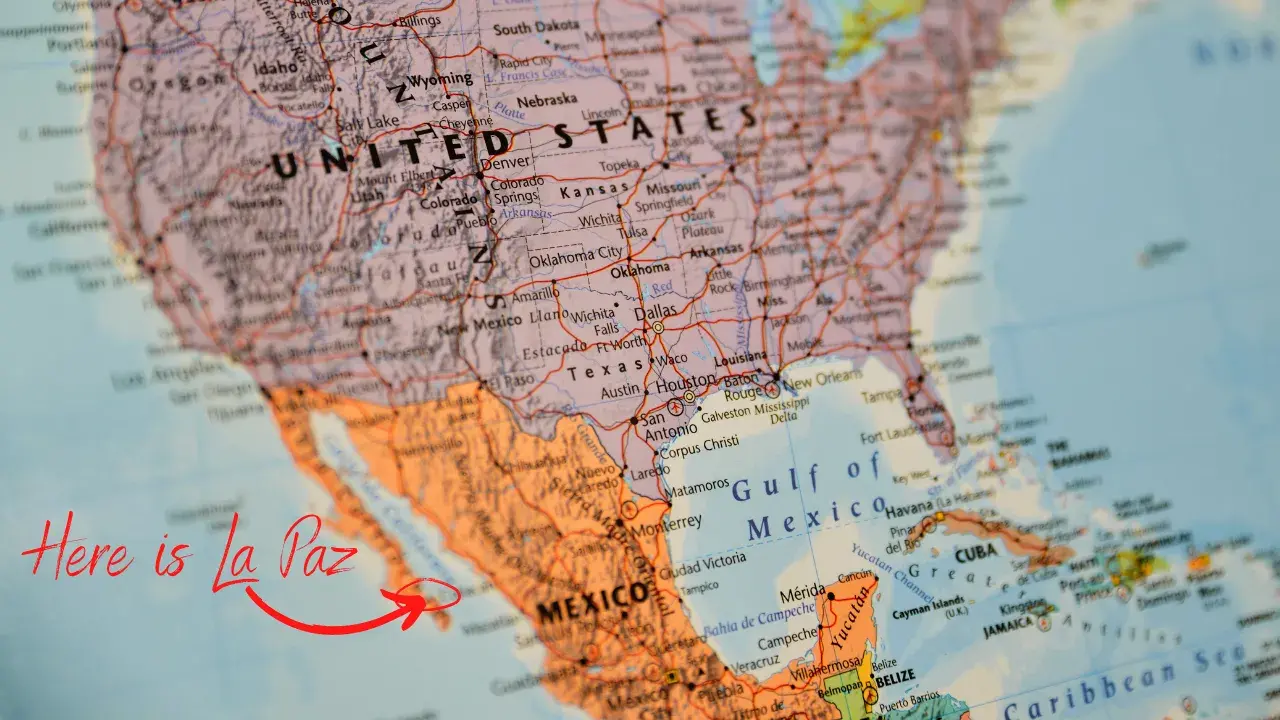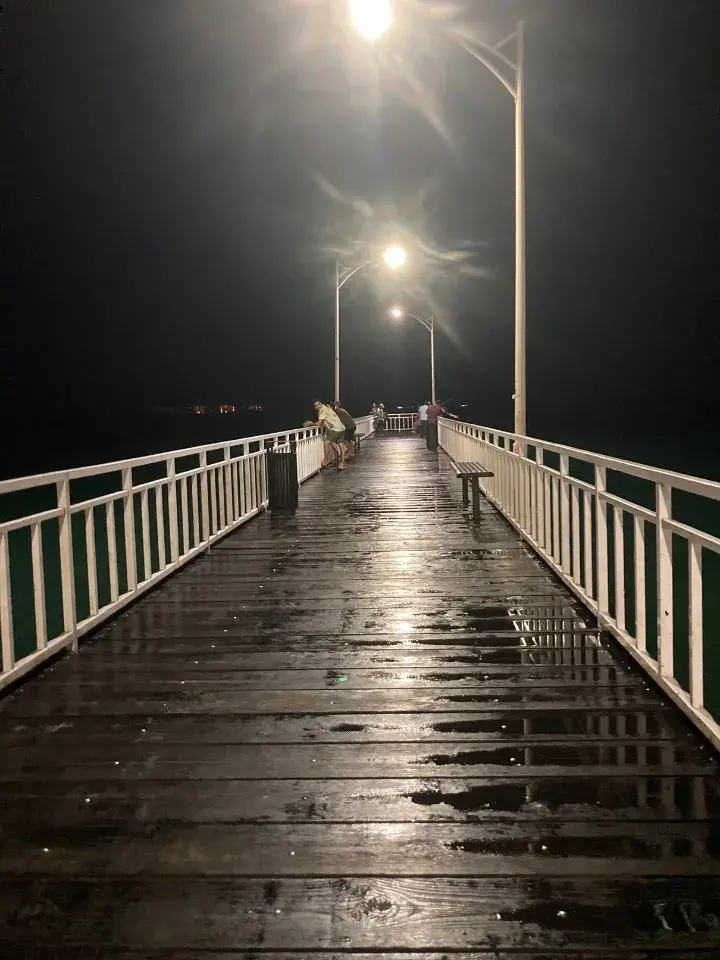Where is La Paz Mexico, located?
By Arthus. • Posted April 9 • 2024.
The beautiful and unique city of La Paz is located in the northwest of Mexico, right by the Sea of Cortez. This allows you to find everything from golden sands and crystal-clear waters to hills and deserts, even vineyards, all framed by the serene tranquility of its inhabitants and the peace that its daily life conveys. La Paz's location is truly privileged, offering its visitors and residents a wide range of activities, including beach outings, adventure exploration, as well as cultural and urban experiences, among many others.
A small and beautiful city
La Paz is a small but beautiful city located approximately 1041 miles from Mexico City (the capital of Mexico) and 1,072.6 miles from Los Angeles. This means it's not impossibly distant from major urban centers, both in the USA and Mexico. A flight to this paradise takes about 2 hours. Its airport, much like the city, is small but incredibly functional and comfortable, serving its purpose of welcoming travelers and residents in the best possible way. It is, of course, the main gateway for foreign visitors to this destination.
You might also be interested in:
Once you're in La Paz, you'll see we're not kidding: the city is small and beautiful, with all the comforts and essential services within short distance (for instance, I can walk to the supermarket and it takes me less than 10 minutes to get there), making it a very convenient place to live and, of course, to visit. Anyone who has traveled to La Paz knows what I'm talking about. The distances for the vast majority of activities are short; everything is close, everything is readily available. Of course, there are incredible places like La Ventana or Todos Santos that are further away, but they are technically outside of La Paz, so if the plan is to make the most of the city, you'll find everything within easy reach.
Don't be mistaken, this is a small city, yes, but don't think it's a Mexican village like the ones Hollywood has misrepresented for years, a hamlet filled with cacti and people on horseback, wearing large hats on their heads. ABSOLUTELY NOT. It's a city full of shops and services, good, hard-working people, with streets in good condition (with its exceptions, like any city, of course) for cars and public transportation services, well-connected and quite safe, with great weather and indescribable natural beauty. Well, although to be honest, being a city in the middle of the desert, there are indeed cacti, LOL. But aside from that, it has nothing to do with what we've been told for decades about Mexico.
Is La Paz in the US?
Believe it or not, this is a question I've received and seen in various places: Is La Paz in the States? I mean, La Paz is located in Baja California Sur, so if California is in the States, it's obvious that Baja California is too, right? Then La Paz must be in the United States. Well, no, this is incorrect. Both Northern and Southern Baja California are states belonging to Mexico. While they are indeed a natural extension of California, the border between San Diego and Tijuana divides them, so it's not accurate to say that this beautiful city is within the borders of the States. So, if you thought you didn't need your passport to travel and discover this paradise, you need to revisit your geography lessons, because this city is more than ready to welcome travelers from around the world, but it will only receive foreign travelers with their passports. Don't forget, La Paz is not in the United States, but in Mexico.
I'm not lying when I say this confusion exists among certain people. In fact, not long ago, my wife showed me a TikTok of a Canadian guy in Cabo San Lucas (two hours south of La Paz) who was clearly drunk and causing a scene. So, someone called the police, and do you know what the guy's first reaction was when he got arrested? He demanded that the American police come! Incredible, right? Then, once the police were taking him away (doing their duty), he asked them to call Canada or something like that. He was really drunk.
Here, I’d like to take the opportunity to remind you that if you're going to drink a lot, there are always better places to do so than in public, in a hotel, in a foreign country, surrounded by people who don't speak our language. And while, generally, they're very welcoming to visitors, they're not willing to tolerate these kinds of excesses. This is especially true in La Paz. The people are friendly, but they know that if a gringo goes over the line and causes trouble, a call to 911 will get them arrested and taken away from there. Don't forget, La Paz is in Mexico, not in the States... Baja California is not "California below"; it's a state belonging to another country.
How to get to La Paz?
The most comfortable and fastest way to get to La Paz, assuming you're coming from abroad, is by plane. Another method I've seen a lot, although I haven't personally experienced it, is in RVs, which cross the border, travel the entire Baja Peninsula, and stay a few days in La Paz before continuing on to Los Cabos. Of course, it's possible to arrive from San Diego or Los Angeles by car, and indeed, it's a road trip I've long wanted to take, but I haven't made up my mind to do it yet. Another way is to arrive from Mazatlan, Mexico by ferry, a journey that takes about a day, and I've heard good things about it, but I haven't wanted to do it for a very personal and simple reason: I get seasick easily.
Regarding the option of flying, I'll just say that as far as I know, all flights to La Paz from abroad have a layover in Mexico City (CDMX), which can be longer or shorter depending on the season, airline, etc. Perhaps in the last few years, since I've been living here, this has changed, but the last time I checked, it was still the same. Personally, I travel to Mexico City relatively frequently, so my natural flight back to my new home is CDMX-La Paz. For this option, I do recommend ensuring that your flight only has a layover in CDMX. Some airlines include another stop in cities like Guadalajara or Tijuana, which would make the trip longer. Of course, it's possible to arrive by plane from other Mexican cities, such as Tijuana or Monterrey, to name a couple, but CDMX is simply the hub of this country in more ways than one, so the frequency of flights from there is higher and the airport is much larger than any other in Mexico. Although it's really overcrowded, flights to La Paz depart relatively smoothly (there was a project to build a new, much larger and more functional airport, but the guy who won the presidency in 2018 canceled it to build a smaller airport far from CDMX). Thus, most flights from major cities in the United States, Canada, or Europe destined for La Paz will have a layover at the Benito Juarez Airport in CDMX. Based on my experience, my personal recommendation is if you're going to use a Mexican airline, fly with Aeromexico.
If you're taking the road from the border down here, you should take the Transpeninsular Highway that runs the length of the peninsula and is in good condition. Please, be more cautious—while I can attest that La Paz is extremely calm and safe, the roads from Tijuana down here might not be as much. From experience driving on Mexican highways for years, I can tell you to follow the road signs, cooperate with the authorities, and preferably not travel at night, at least not until you reach Baja Sur, where I can say the only problem is wanting to stop every moment to admire the beauty of the starry sky.
Regarding the ferry option, I can only say that I've seen those ships, and I know they carry people and all the freight trailers from Mazatlan to La Paz. Don't get me wrong, there are of course cabins for people, but these are not ships solely for passengers; they also transport, like all ferries, cars and trucks. This is vital for La Paz, as transporting goods by road would be enormously time-consuming. One would have to cover a huge distance (let's not forget that the city is on a peninsula), so taking a ferry trip is much more effective, both for people wishing to travel to and from Mazatlan and for all the goods needed for a city of over a quarter million people to thrive.
Is La Paz dangerous?
So, we now know that La Paz is in Mexico, in the northwest to be more precise, which may lead many to wonder... is it a dangerous place? The short answer is simply no, it's not a dangerous place; quite the opposite, it's a safe and peaceful place, where the tranquility of its waters is reflected throughout the city. This isn't just a saying. A few months ago, a Mexican politician came and said something along the lines of "even the waves are calm in La Paz," and some of my friends were offended, but I took it as the city being so tranquil that everything is calm, including its waves. I wrote an article where I delve deeper into why La Paz is such a safe and serene city. You can find it here. In that article, I list the reasons why, from my perspective, this city is a safe and quiet place that lives up to its name "The Peace," and how sometimes we only hear about Mexico's negatives from the US media and forget that this country is much, much more than that.
But for your peace of mind, I can assure you that La Paz is one of the safest places in North America (yes, Mexico is in North America), close to the safety levels of Canadian cities, with a calm, friendly population that appreciates, values, and cares deeply for the tranquility that permeates this city at all times. So, as I like to say whenever someone asks me if it's safe to visit this paradise... the only risk is that you'll want to stay (it happened to me, LOL).
Best Time to Visit La Paz
Without a doubt, autumn, especially for those visiting this city for the first time, is the perfect season to get to know, appreciate, and enjoy it to the fullest. And there's a powerful reason for this, which is simply that... The weather isn't so hot: In autumn, the climate is very pleasant, mild, and the water remains warm too, so swimming is delightful and walking around the city is very enjoyable (Anyway, don't forget the hat, never forget the hat and to stay hydrated). This isn't the case in summer when the city experiences very hot weather and it can be overwhelming for first-time visitors to La Paz. That is, there's nothing to worry about, as long as you protect yourself from the heat, hat, sunscreen, sunglasses, and staying hydrated are things you should always have on hand here, but in summer it's even more indispensable, even for the locals, so for a first visit, we recommend coming in autumn.
So, we recommend summer for those who have already been to La Paz, or for those who aren't too bothered by the heat, because it's also a season where you can do a lot of activities both in the city and, of course, on its beaches. In this case, as the locals (we) say, it's always best to avoid the peak sun hours, between 3 and 5 pm, where we can have lunch, grab a drink, or do something indoors. I repeat, there's no major problem as long as we follow the recommendations: hat, sunglasses, sunscreen, and staying hydrated. But, truly, at the risk of being repetitive, there are people for whom the heat of La Paz's summer can seem overwhelming. I remember my first summer here; it was really intense for me, not being used to this heat. I mean, we've had moments of 104 degrees Fahrenheit or more, and although the sea breeze always helps, it doesn't reach everywhere all the time, so you have to take the precautions I've already mentioned. This applies to both foreign and Mexican visitors because I've talked with tourists from Mexico City who had no idea how hot La Paz gets in the summer and thought it would be similar to the heat at other beaches in their beautiful country. Nope, here in La Paz, the summers are very hot.
If you come in the winter, prepare for a surprise—it's cold here! Not the intense cold of an American or Canadian winter, of course, but it is cold, especially in the mornings. If you were thinking of fleeing the cold to come to warm Mexico, I have bad news for you. This is the Mexican northwest, closer to LA than to Mexico City, and quite far from Cancun, so if your desire is to escape the cold to a warm climate with cold drinks, honestly, you're better off heading to Cancun, the Riviera Maya, or Mérida. La Paz is cold in winter, and the water of its seas, although beautiful and crystal clear all year round, is really cold, and the only safe way to enter during these times is with a wetsuit. But if your desire is to get to know the city itself, its museums, its cuisine, its people, and its indescribable natural beauty without wanting to swim, except maybe in the hotel pool, it's a great season to visit, because the heat won't be a bother.
In the spring, we all know that plants bloom, the weather improves, and this city looks beautiful because, even though it's in the middle of the desert, the people and authorities take care to maintain their plants and flowers to beautify their homes, streets, and medians. It's a great season to get to know the city and enjoy many activities, including swimming... but the water is still cold, not as much as in winter, of course, but cold, though it's already possible to swim without a wetsuit, and the sun starts to feel warmer. Let me share about my first time here in La Paz; I traveled precisely in the spring and visited Balandra during that season, beautiful, the colors incredible, and the water... cold. I went in, started to swim, and the first thing that hit me was a cough that lasted a couple of minutes. Of course, once my body adjusted to the temperature, I was able to swim and enjoy without much trouble, except for the occasional cough. But even in spring, the water is cold, and we locals have a saying that goes something like "if they swim in cold water, they're a tourist"... now, with a few years here, we know it's better to wait until the water is warm.
It's important to mention that all of this depends, of course, on what activities you plan to do during your visit to La Paz. That is, if you're coming to do kitesurfing in La Ventana , you should come from November to April, when the winds are strong at that beach and allow for the practice of this sport. If you're coming to see the whales, you need to come between January and April (depending on the beach). If what you want is to swim in the crystal-clear waters of this city to your heart's content, but you don't like intense heat, you should come in autumn. In other words, you need to analyze what you want to do to know the ideal season for you to visit La Paz. That said, no matter the season you come, La Paz has something incredible for you and your family all year round; of that, have no doubt.
To see more incredible pictures, go to the Pinterest board for this article: Click

Tastes of La Paz.




